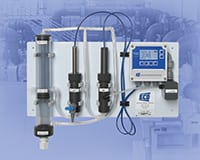Monitor hydrogen peroxide in water-treatment applications
The advanced HP80 hydrogen peroxide analyzer (photo) measures hydrogen peroxide in terms of both parts per million (ppm) and the percent solution range to support a variety of process applications. It is easy to set up and use, right out of the box with no special tools, says the company, thanks to its plumb-and-play design. The analyzer system includes a hydrogen peroxide sensor, a pH sensor, a constant-head flow-control device (to maintain the optimum flowrate moving past the sensor during sampling), and transmitter with power supply, all mounted on a PVC wall panel. The HP80 analyzer features amperometric hydrogen peroxide sensors, which are manufactured with a gold cathode, silver anode and rugged microporous membrane. The operating temperature range for these sensors is 0 to 45°C (32 to 113°F). — Electro-Chemical Devices, Irvine, Calif.
